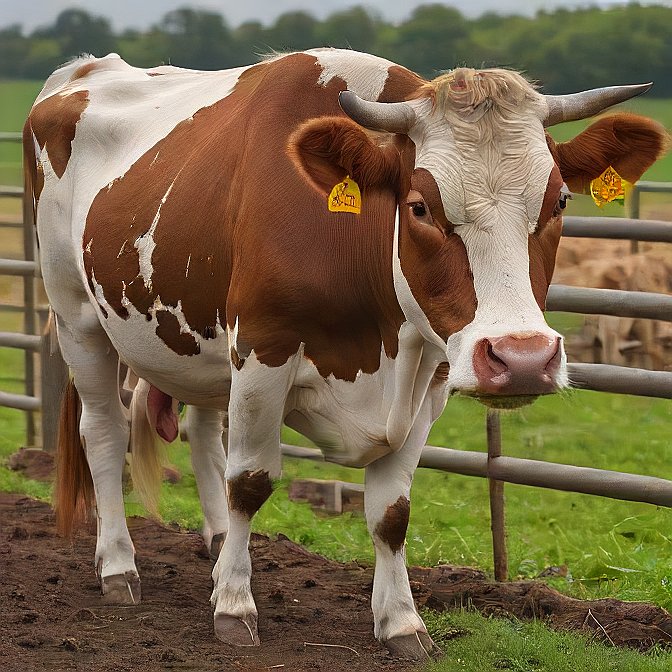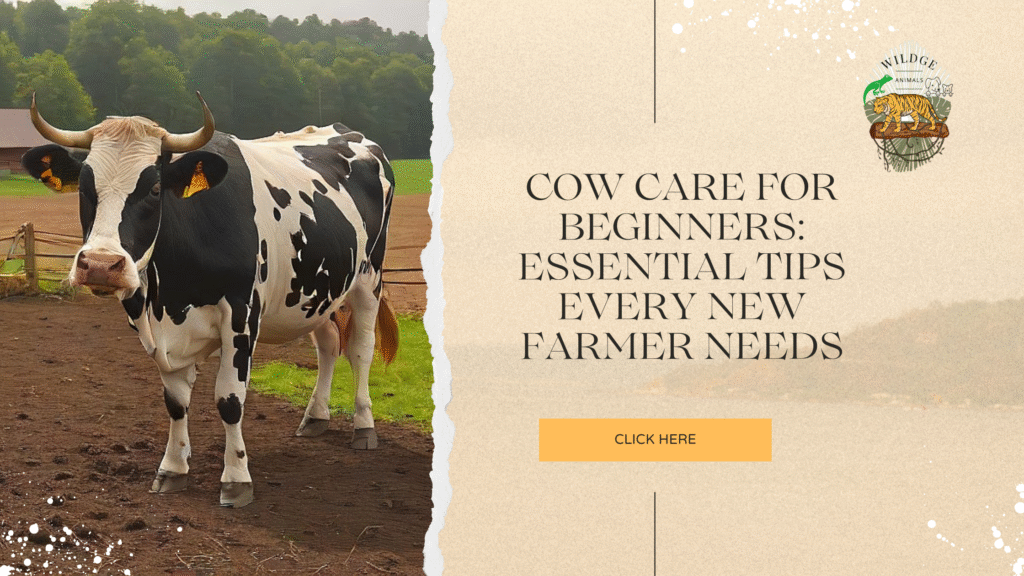Table of Contents
Introduction: Why Proper Cow Care Matters from Day One
Being a farmer when you are just starting your career could be very thrilling and overwhelming, especially as far as keeping livestock is concerned. As a novice farmer, it is wise to learn the most basic concepts of the process of taking care of cows so that you can maintain healthy and stress-free, and reproduction-free animals. The proper running of any farm business, whether you are connected with cows as a milk producer or a meat producer or for any other reason, such as a small homestead, the process by which you tend them will directly reflect on their well-being and long term revenue of the farm.

This book demystifies all the knowledge you should have on how to feed and house, health measures, and behaviour pointers to make sure you establish a great background in the rearing of livestock. Happy, successful cows can be obtained even by first-time farmers by following the rules and maintaining the proper level of knowledge and daily habits.
Cow Care for Beginners: Understanding the Basics First
This is a technical routine that you should not give in to until you have the impression of the fundamentals of cow care as a novice. Every cow to keep healthy and productive requires a rhythmic regime of clean water, healthy nutrition, and correct shelter. Such routine necessities are not merely about survival, but they speak to behavior, milk production, and life sustainability.
Monitoring is a giant in itself in showing any early manual symptoms. The problem can be manifested by changes in eating habits, movement, or even temperament. Set up a routine and follow it- cows love routine. Finally, know the breed of your cow. There are others that are more heat tolerant, others that can take richer diets. Being conscious of what your breed requires can save you a headache in the future
Building the Right Shelter: Clean, Dry, and Well-Ventilated
An ideal cow shelter is one that offers shelter on a year round basis. Regardless of the number of cows under care, a well-ventilated, clean, and dry place is a requirement. The correct circulation of air assists in the prevention of respiratory diseases, and clean floors lower the chance of developing hoof infections and parasites.
The shelter must be made to be easy to clean, too. Accumulation of manure not only negatively affects the health of the cows, but also invites pests. A clean and healthy living environment requires frequent changes of bedding and wet removal. Ensure that your house is designed to safeguard against harsh weather-covered shelters in the hot seasons and in frigid one or the other case.
Feeding 101: What to Feed and When
Nutrition of the cow is the major issue contained in any guide on how to care for a cow as a beginner. Cows require a variety of food that consists of roughage (hay or pasture), grains, as well as the required minerals. The roughage makes the digestion process easy without much bloating, in addition to grains, which meet the energy requirements, especially in lactating cows.
Breed, weight, and age also determine the amount of food that it receives. The breed also determines its productivity. Be mindful of body condition by checking every now and then and using that to regulate portions. The feeding program should also vary with the seasons. In winter, the feed given to cows may require a high amount of calories, and conversely, the summer diet may spend much on water and roughage.
Check Out: Best Cow Breeds for Maximum Milk Production That Every Farmer Must Know.
Watering Needs: Never Underestimate Clean Water Access
One is to pay attention to the simplest things in cow health care, such as clean water, which is a very big essential. A grown cow can have an intake of 30-50 liters daily, and more so during lactation and in hot climates. Water affects digestion, temperature, and the productivity of the body.
Make sure that water is readily available and that there is clean water that is refilled regularly. Trough cleaning or tank cleaning must be done on a regular basis so as to prevent the presence of bacteria. It also depends on the temperature; in winter, drink lukewarm water and during seasonal times, cool water, to hold the drinking habits.
Look out to avoid dehydration, as swollen eyes, dry noses, and the milk production by the goats will be little.
Routine Health Checks and Vaccinations
The vital pillar of caring about cows is health management by a beginner. Create a fixed routine for essential health check-ups-observe the condition of the coat, clarity of eyes, appetite, and behaviour. It will help you to save on treatment and avoid losing early.
The inoculations need not be compromised. The calves, as well as the adult cows, were susceptible to diseases such as the foot and mouth disease, brucellosis, and the blackleg, and this is why they had to be shielded. Regarding the breeding, you need to check with the local vet to come up with a deworming and vaccination program, depending on the region and breeding.
Though there are some health complications that can be taken care of at home, you should not be afraid to seek the assistance of a vet when signs and symptoms have not subsided. The availability of a professional can go a long way.
Grooming and Cleanliness: Keeping Your Cow Healthy and Comfortable

Grooming is not only about looks; it also plays a significant role in caring about the cow when someone has just started taking care of animals. One method, which is the use of brushing, is useful when it comes to eliminating debris, improving the flow of blood, and also the possibility of detecting some skin disorders or external pests before an actual infection is produced. You also need to take care of the hooves; they should be trimmed to prevent painful infections or lameness.
Other significant factors are clean beddings. The wet, dirty bedding serves as a breeding habitat and is related to asthma and mastitis. Change beddings often and keep the shelter dry. Grooming also helps you and the cow to be more bonded together; hence, the cow becomes more trustful and easier to manage
Milking Practices: Gentle, Regular, and Hygienic
Milking technique is very important to those who are in charge of dairy cows. When new farmers inquire about the process of beginning milking, they are advised to be gentle, and routine is the key. This should start with cleaning the udder to prevent contamination. To avoid infections (mastitis), clean hands or use sterile milk-handling parts.
The procedure of milking must be frequent and conducted at specific times of the day to ensure the comfort of the cow and to sustain the supply of milk. Regularity alleviates stress and stimulates the reflex of lettuce. Clean, quiet milking space should not be distracting. A relaxed and sanitary installation of milking is a long-term care in the cow care for beginners.
Breeding and Calving Basics for New Farmers
The reproduction feature is a significant component in livestock. This is crucial, especially to the first people who understand when your cow is in heat and what method to use during mating, whether natural or through the use of artificial insemination. The cows will be in heat usually after 18-24 days and they may display this behavior with restlessness, mooing, or mounting of other cows.
Before calving, you should be on the alert for signals that a cow is to calve, and these signs are swelling of the udder, seclusion, and pacing. It is important to get it ready, to have space and means, something to clean with, e.g., towels, gloves, disinfectants. After the birth of a calf, make sure that you administer colostrum within the first few hours, and carry out a follow-up of the two animals to make sure there are no complications.
Cow Behavior 101: How to Handle with Care
Cow care is an essential aspect that every novice should know how to deal with cows. Cows are social and intelligent. They use body language to express themselves. Irritation or stress may be evident in raised ears or in pawing or flicking of the tail. Supportive behavior is promoted by ignoring and less explosive behaviors on your part.
The cows can learn to recognize your voice or to react to your daily rituals, or they can even learn to react to your touch with time and kindness. Do not startle with sudden noises or treat the animal roughly, as these are easily frightened positions to the procedure.
Common Mistakes in Cow Care for Beginners (and How to Avoid Them)

Not even the best intentions of new farmers are problem-free. Overfeeding on grain, which may cause bloating or metabolic issues, is one of the common problems. Malnutrition can also be as debilitating as underfeeding on mineral supplements. The second one is neglecting low-level symptoms of health issues, which might be taken as a slight limp or cough, and might become a bigger problem once it is left untreated.
Poor shelter design, pollution in water, and lack of hygiene are often some of the realities that are, in many cases, the cause of easily avoidable illnesses. There is also the tendency to attempt to hurry taming or training up a skittish cow, which is again counterproductive. How to escape these pitfalls best? Learn as you go, watch all the time, and ask the important farmers or the veterinarian in case of doubt.
Conclusion: Start Smart with Confident Cow Care
As a beginner, it may seem, you are diving into the world of cow care with no idea what to expect and how to deal with this task, but with a proper education, it will be an easy and even pleasurable journey. The daily routine of feeding and taking care of shelter, in addition to health check-ups and light handling, is an activity that can make sure your cows are happy and thus productive.
The more you watch, study, and adjust, the better you will know what your animals need. Avoid diversity in cow care, be patient, and demonstrate being sincere to cow welfare, and build a successful dairy business or a small homestead.
Study the type of cow, ask around the farmers at home, and also relate with the vets in your area so that they can help you with the farming challenges in your area before you purchase your first cow. Smarter planning in the present, and fewer issues in the future.
For more info: Click Here.
FAQs: What is the Beginner’s Guide to Cow Care?
Q1. And how many acres will it take to keep one or two cows on it?
The space required by an isolated cow is about 1-2 acres of pasture, and a clean place to shelter. When it is in small-scale operation, space efficiency and rotation of pasture are important.
Q2. When do I have to feed and water my cow?
The food and water need to be provided at the same time daily. In the case of weather and lactation status, adult cows may take 30-50 liters of water per day.
Q3. Does it take a long time to learn how to milk a cow?
It can appear difficult initially, but it takes practice, in which most of the beginners are comfortable after a few days. The trick is to touch softly, to use clean supplies, and to have a peaceful routine.



